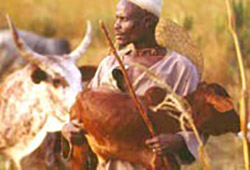Resource 4: Cattle in traditional life – the Maasai
![]() Background information / subject knowledge for teacher
Background information / subject knowledge for teacher
The life of the Maasai tribe of Kenya and Tanzania centres around their cattle, which constitute the primary source of food and the focus of their economy. They believe that God gave them his cattle to watch over, and virtually all social roles and status derive from the relationship of individuals to their cattle.
The Maasai class is determined by the number of cows owned by the family so they are rarely killed, but instead are accumulated as a sign of wealth and traded or sold to settle debts. At one time, young Maasai warriors set off in groups with the express purpose of acquiring illegal cattle.

Their traditional grazing lands span from central Kenya into central Tanzania. Young men are responsible for tending to the herds and often live in small camps, moving frequently in the constant search for water and good grazing lands. Being nomadic, the Maasai construct temporary houses out of cow dung and mud. This mix dries quickly in the sun and is almost as hard as cement and does not smell. The houses are built in a circle and, at night, all of the cows are placed in the centre, safe from wild animals.
Cow's milk, together with blood, is the staple food of the Maasai, who eat no fruit or grain. Once a month, blood is taken from living animals by shooting a small arrow into the neck. This blood is then mixed with milk in a gourd that has been washed with urine to prevent spoilage.
Adapted from http://www.uiowa.edu/ ~africart/ toc/ people/ Maasai.html [Tip: hold Ctrl and click a link to open it in a new tab. (Hide tip)] , http://en.wikipedia.org/ wiki/ Maasaiand http://www.ansi.okstate.edu/ breeds/ cattle/ masai/ index.htm (Accessed 2008)
Resource 3: A mind map about keeping cattle



